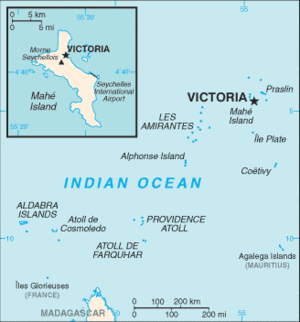الدبراء
| ||||||||||||
| ||||||||||||
الدبراء، هي ثاني أكبر شعاب مرجانية حلقية في العالم، وتقع ضمن مجموعة جزر الدبراء بالمحيط الهندي الذي يشكل جزءاً من سيشل. وهي جزيرة معزولة وغير مأهولة بالسكان، ويوجد بها مجموعة فريدة من الحيوانات منها سلحفاة الدبراء العملاقة، وهي مصنفة ضمن مواقع التراث العالمي.
. . . . . . . . . . . . . . . . . . . . . . . . . . . . . . . . . . . . . . . . . . . . . . . . . . . . . . . . . . . . . . . . . . . . . . . . . . . . . . . . . . . . . . . . . . . . . . . . . . . . . . . . . . . . . . . . . . . . . . . . . . . . . . . . . . . . . . . . . . . . . . . . . . . . . . . . . . . . . . . . . . . . . . . .
التاريخ
Aldabra was visited by Portuguese navigators in 1511. The islands were already known to the Persians and Arabs, from whom they get their name. In the middle of the 18th century, they became dependencies of the French colony of Réunion, from where expeditions were made for the capture of the giant tortoises.
In 1810 with Mauritius, Réunion, the Seychelles and other islands, Aldabra passed into the possession of Great Britain. Réunion was returned to France, and Mauritius gained possession of Aldabra as well as the rest of the Seychelles. The previous inhabitants were emigrants from the Seychelles. Sailors landed on the atoll in the 19th century and attempted to raid the island for tortoises as food; in 1842, two ships were reported to have taken 1200 of them. By 1900, the tortoises were nearly extinct, and a crew would often have to hunt for three days to find one.[1]
The Aldabra Atoll, along with Des Roches and Farquhar, was part of the British Indian Ocean Territory from 1965 until Seychelles independence in 1976.
الجغرافيا
النباتات
Aldabra has a number of endemic plant species. The higher areas are covered in species of pemphis, thick coastal shrubs, while the lower areas which are home to the giant tortoises, are a mixture of trees, shrubs, herbs and grasses.
الحيوانات
The atoll is home to the world's largest population of giant tortoises, the Aldabra Giant Tortoise (Dipsochelys dussumieri), numbering some 100,000 individuals.[2] They are also known for their Coconut crab (Birgus latro), the world's largest land crab, and hammerhead sharks, manta rays, barracuda and as a breeding ground for green turtles and hawksbill turtles; in older times, its dominant land predator was the crocodillian Aldabrachampsus. Birds of Aldabra include the Aldabra rail, the last surviving flightless bird of the Indian Ocean region, and the endangered Malagasy Sacred Ibis as well as large numbers of nesting seabirds. Two species of bats, Paratriaenops pauliani and Pteropus aldabrensis, are known only from Aldabra.[3]
قائمة الجزر الصغيرة في البحيرة الضحلة
|
|
|
البيت الملكي
انظر أيضاً
- أديايتا - سلحفاة عملاقة في الدبراء. ماتت وعمرها 250 عام على الأقل في حديقة حيوان كلكتا في 20 مارس 2006
- جغرافيا سيشل
المصادر
- ^ Carpin, Sarah,(1998) Seychelles, Odyssey Guides, p.162, The Guidebook Company Limited, Retrieved on June 22, 2008
- ^ Payne, Roger (2004-04-05). "Losing Aldabra". Voyage of the Odyssey. PBS. Retrieved 2008-10-21.
{{cite web}}: Cite has empty unknown parameter:|coauthors=(help) - ^ Goodman, S.M.; Ranivo, J. (2008). "A new species of Triaenops (Mammalia, Chiroptera, Hipposideridae) from Aldabra Atoll, Picard Island (Seychelles)". Zoosystema. 30 (3): 681–693.



